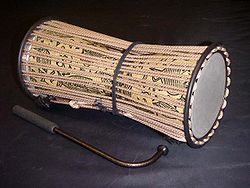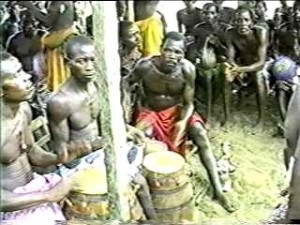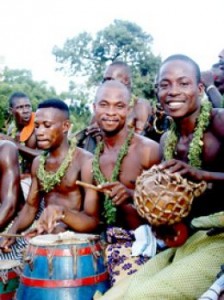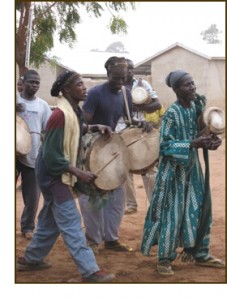Russell Hartenberger pres ents a hands-on West African Drumming
ents a hands-on West African Drumming
Workshop in which participants play drum ensemble music from the
Ewe, Akan and Dagomba people of Ghana. Polyrhythms, call and
response, talking drums, all fascinate Russell and he enjoys sharing
that fascination with workshop participants. Russell has explored
these elements in his own composition The Invisible Proverb,
featured on the NEXUS CD Drumtalker.
Russell’s workshop can accommodate any number of people. Groups of 8-10 at a time learn to play on traditional West African
instruments. The rhythmic construction of the music is analyzed and Russell demonstrates performance techniques. The workshop also includes discussions on the social context of the music, the relation of West African music to Western music and the use of standard Western percussion instruments as substitutes for West African instruments. The workshop runs between one and two hours depending on the number of participants.
 The Ewe are a seaside people of the southeastern corner of Ghana and nearby Togo, renowned for their drumming and singing. Dance-drumming is an integral part of their community life and everyone participates: the male and female elders, the composer who is responsible for the creation of the
The Ewe are a seaside people of the southeastern corner of Ghana and nearby Togo, renowned for their drumming and singing. Dance-drumming is an integral part of their community life and everyone participates: the male and female elders, the composer who is responsible for the creation of the
distinct texture that forms the Ewe dance-drumming style, the lead drummer and the ensemble of supporting drummers, singers and dancers.
 The Akan people are also of southern Ghana and adjacent Cote d’Ivoire and Togo. Their communities hold drummers in high regard, and their form of the talking drum is called the “atumpan”. Akan musicians use
The Akan people are also of southern Ghana and adjacent Cote d’Ivoire and Togo. Their communities hold drummers in high regard, and their form of the talking drum is called the “atumpan”. Akan musicians use
the tension head on the atumpan primarily to create a falling pitch on drum strokes, achieving a wide tonal range.
 The Dagomba people make lunga and gung-gong drums from cedar wood, and the job of felling the trees and carving the logs into the drum shape is a special one. The drummers themselves then turn the wood
The Dagomba people make lunga and gung-gong drums from cedar wood, and the job of felling the trees and carving the logs into the drum shape is a special one. The drummers themselves then turn the wood
shells into lunga drums using goat skin, antelope skin, cane, and grass. The drum sticks too are a particular art. A wooden branch is carved to approximate size, boiled until flexible, and then bent
into a curved shape and held there with a goat skin cord. Once cooled, the drummer can whittle the stick to smoothness. You can read more at Elana Cohen-Khani’s website on Dagomba Dance Drumming. She created this exceptional website as a graduating senior project at Tufts University last year.
Russell’s workshop is a great opportunity to learn about the important drumming traditions of these communities, and to understand how their music “works”. For more information on presenting this unusual workshop, drop us a line!
